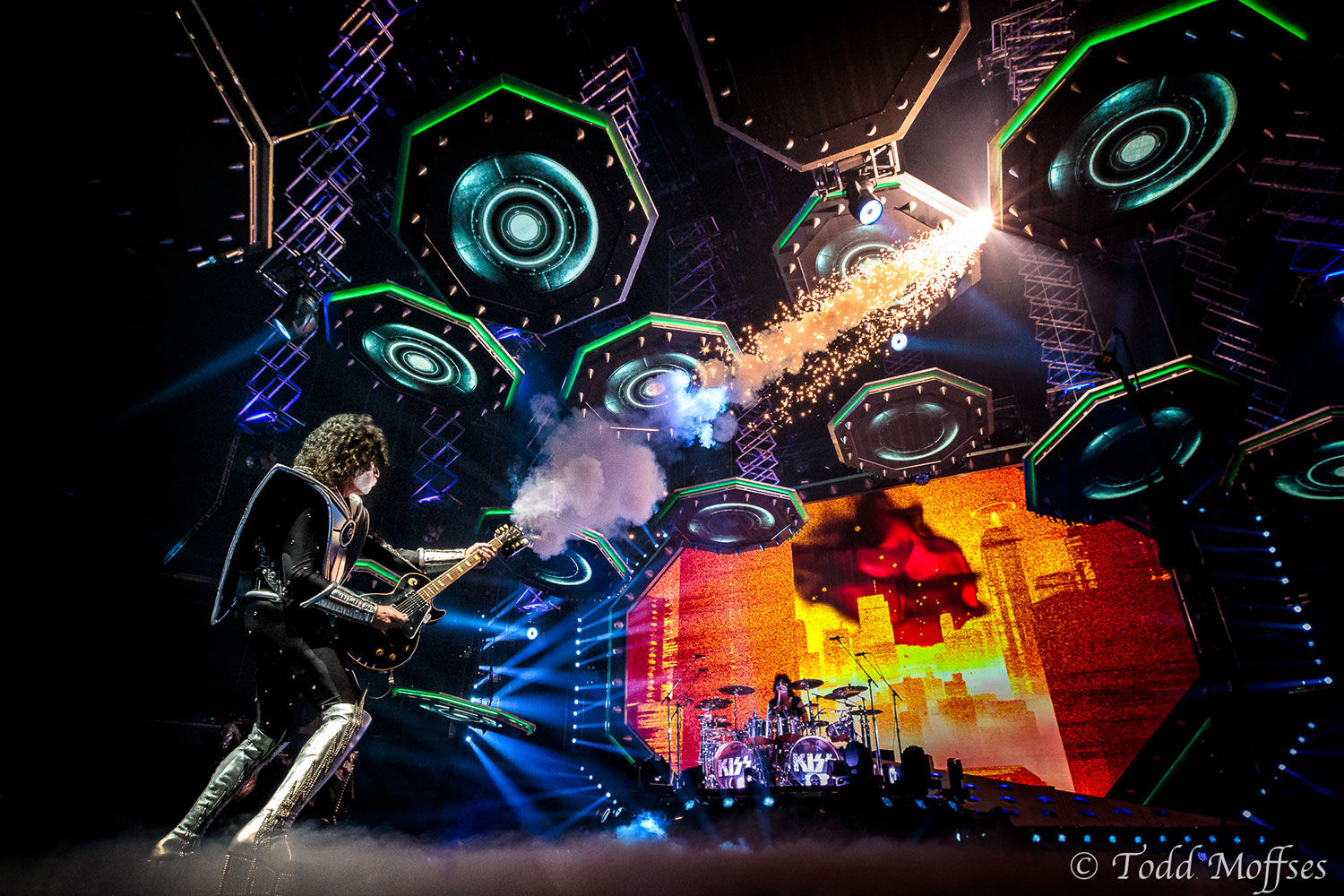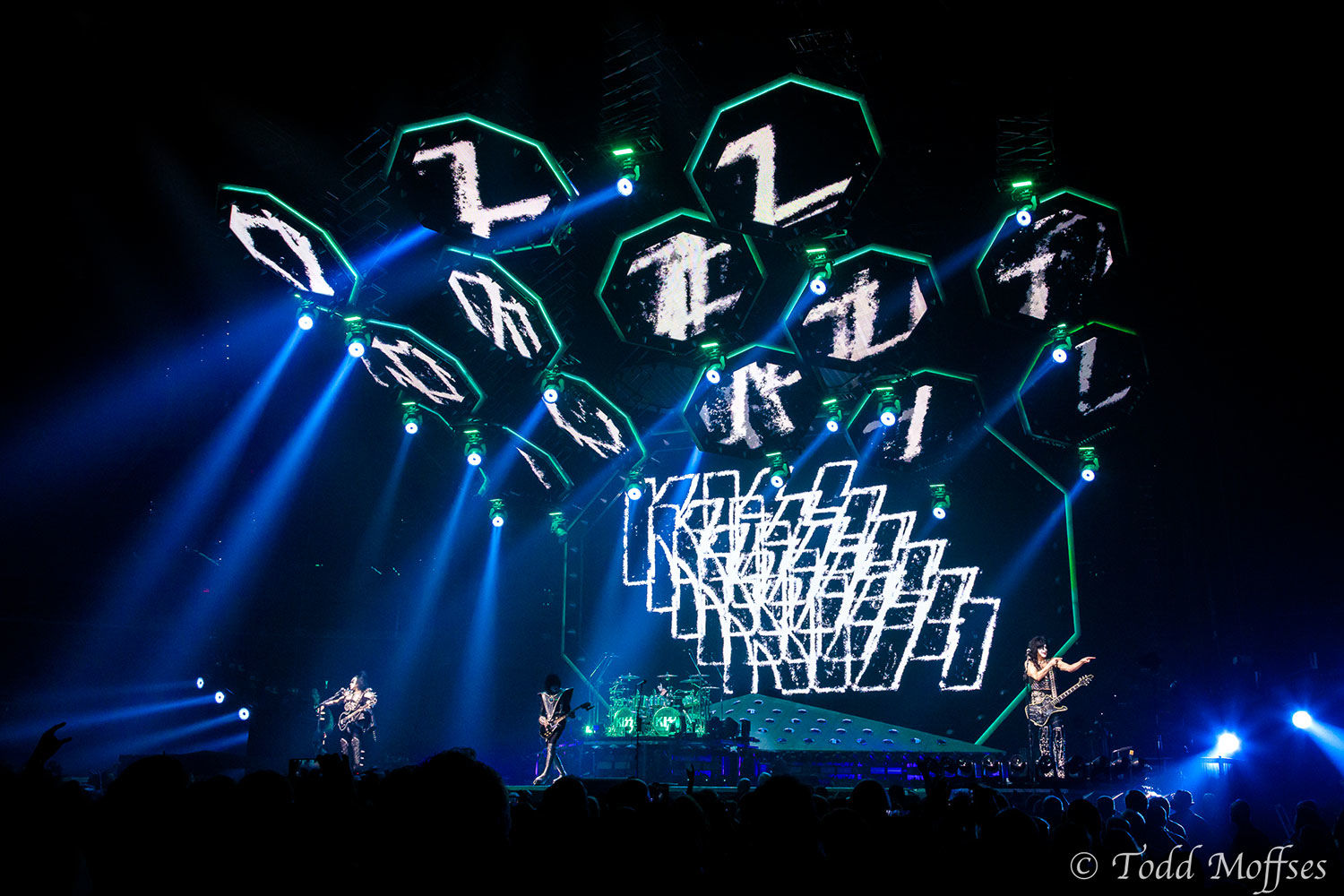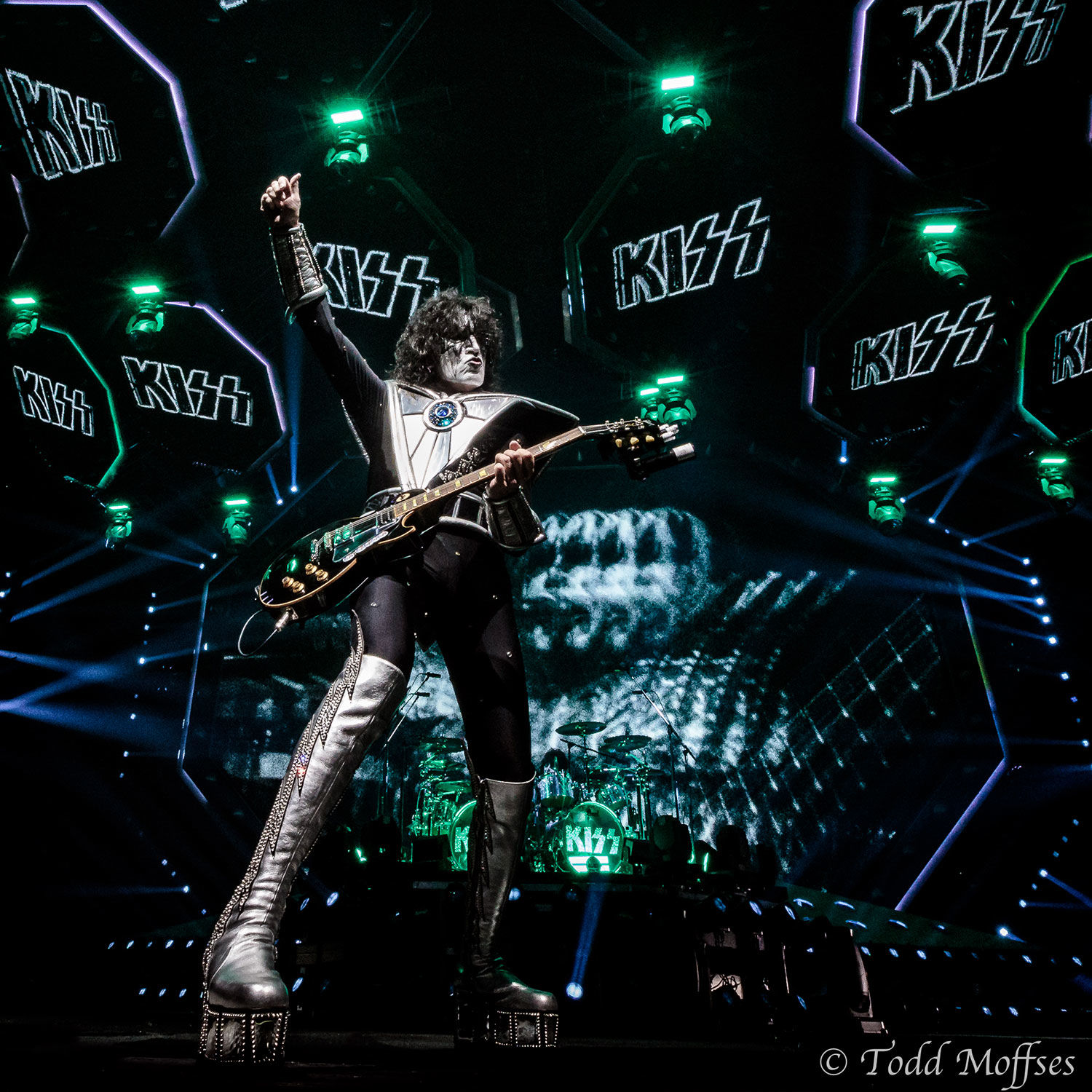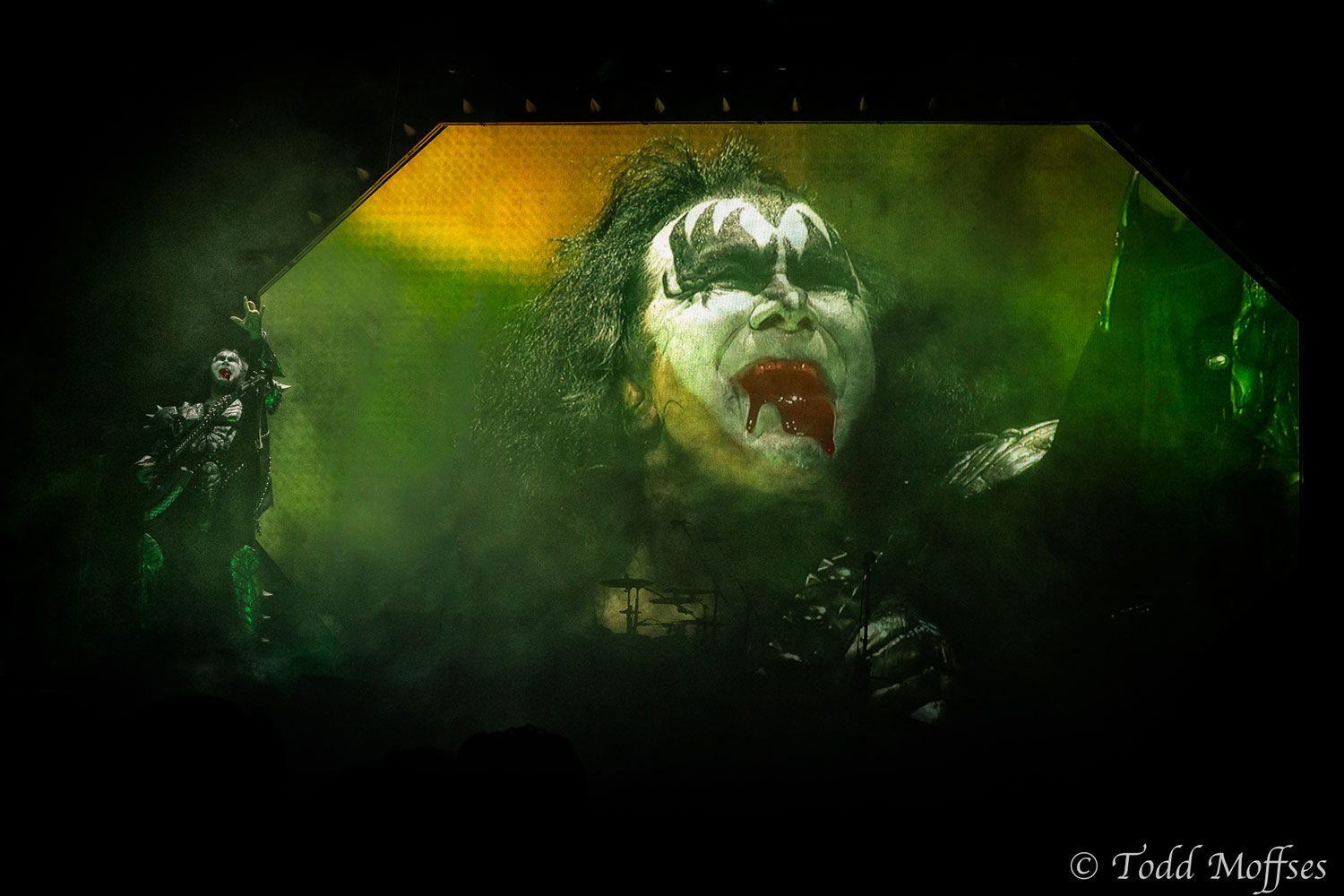Despite touring for nearly half a century, rock giants Kiss are still looking for ways to bring modern technology and effects into their live show without compromising on their core values.
Kiss are a modern-day rock institution. You might have never heard Strutter or Lick It Up on Spotify, but you’ll likely have seen the iconic Kiss logo or the demon make-up of Gene Simmons et al. at least a few times in your life. But before all the iconic branding came the rock and roll spectacle of the live show.
In the 1970s, when most acts were happy to simply stand on stage and play, Kiss pulled no punches for performances; fire-breathing, spitting blood, pyrotechnics, exploding guitars, and even elevating drum kits were live Kiss staples from early on that continue to this day. Arguably it was this visual spectacle that drove the band’s early success to becoming the commercial behemoth they are today.
Over the years, the Kiss machine has found ways to keep the core elements of the stage show yet reinvent them as new technologies become available, keeping the experience fresh for band and audience alike. Their 2012 Monster tour for example featured a giant robotic spider that moved across the stage, and with their last tour the rock legends are looking to bring a modern visual edge to their classic live theatrics, thanks in part to Notch’s live video and lighting effects software being used on a series of video pods that sit above the band as they play.
Bringing legacy bands into the 21st century
The band, who first performed live in 1973, are currently embarking on what they say is their final tour. The End of the Road World Tour began in January 2019 and is scheduled to perform over 100 concerts across four continents with the last concert taking place in 2021.
By the time Digital Arts meets the crew behind the show at London’s 02 venue, the band is already some 60 shows into the tour by this point, having played across the North America and Europe. While the tour is about celebrating the band before they hang up their platform boots, the End of the Road tour isn’t designed to be a pure nostalgia trip.
“It’s about taking a legacy act and making them relevant while keeping them comfortable in their own skin,” says Kiss production manager Rob Long.
“You don’t want to put kiss under, say, a Muse rig, but at the same time you don’t want to just put a bunch of Marshall stacks on stage either; you have to really kind of kick these guys into the 21st century. Sometimes kicking and screaming.”
“Fans have seen them do all these gigs for years,” Rob elaborates. “We’re stuck with these things, like we can’t change them or get rid of them. So how do we make them really badass?”
While some show staples like Gene Simmons’ fire breathing remain the same, various other elements have been given a modern twist. One of the best examples of this is Tommy Thayer’s guitar solo segment during Cold Gin.
Extended guitar histrionics aren’t anything new in rock and roll, with Kiss themselves having a long history of incorporating pyrotechnics into the guitars themselves for their set pieces. This tour however sees Thayer – the ‘Spaceman’ persona in the band – use his guitar to take down ‘UFOs’ invading Earth via the moving video pods above the stage. Between guitar licks Thayer will ‘take aim’ at the UFOs being displayed on the pods and taking them down one by one in a ball of flames, a show-stopping scene made possible by Notch software magic.

“That went from being one of the most boring parts of the show to one of the most exciting parts, solely because of that ,” Long tells us. “To me that’s a monumental moment because you can do things visually with the band now that you couldn’t have before.”
Kiss: Alive! To new stage innovations
Another way the tour is using real-time processing to merge old footage from the band and blend it into the live feed on stage.
“We took a lot of old black and white content, and we use it in this very weird psychedelic way from old 70s shows, using Notch to create that same psychedelic movement in black and white, merging the old content and live content together. It’s actually one of my favourite effects because it keeps everything really grainy and real.”
The band however had to be convinced the effect had a place in the show.
“That one we had to convince the band to add back in,” says Ashley Zapar, associate designer/show director. “They took it out right away, saying, ‘why does this new 4K video look like we’re back in the 70s?’ Over time though we added it back in and now they love it.”

Off the back of this change of heart, Zapar says the band are coming around to the idea of introducing more effects into the show.
“Once they could see and really understand what these technological pieces can truly can do, that got them started on being creative and kind of pushing their own boundaries to see what they were okay with, what they could create, and see if they could stump us on ways to actually make it happen.”
Making special stage effects easier to create
While new software such as Notch enables lives acts to create new effects, visualisations, and even whole segments of shows, they also allow the teams that create them to work in a smarter way.
“If you’re coming from the lighting world, you’ve always been working in real-time; all the lights, controllers, and all that feedback, it’s always done in real-time” says Luke Malcom, director at Notch. “But in video, you didn’t have that; everything was about going away, building a video that’s hopefully going to be in time, going to play on the stage and – if we don’t like it – go back and render it again.”
“Rather than getting notes at 11pm, returning to sit down with Adobe After Effects or whatever it is they’re using for pre-rendering and rendering overnight, and then reloading all the video the next day, with Notch that’s all getting compressed as a timeline.”
Luke says that lighting and video have always existed as separate workflows and technology stacks, operating as two entirely separate entities despite working on the same show. But with more unified stacks and processes, the two worlds can come together to build a more cohesive live show.

“If you wanted to do real-time in shows you had to find a coder and go away to essentially build the special effects. That meant that as a workflow, it wasn’t just about creative, as you had to build everything technically. Also you had to have the right skillset on the road to then go away and run that.”
“The only things you could really do from a desk was say how fast the video is going to run, basic things like contrast and the like. But with Notch being a content creation tool that can be used entirely in real-time you’ve now got the same workflow that you were used to in the lighting world working into the video one.
“That gives huge freedom to design a production workflow that hasn’t been used before. Instead of having to wait for something to render, I can take the video director and side-by-side we’ll work in a real time workflow for a collaborative affair on-site.
“What you’re getting is a higher quality outcome with substantially less stress – and a lot less late nights.”
A living, breathing tour

Since the London gig Kiss have played over a dozen more concerts, with over 20 or so left between September and the new year. But Rob and the band are still keen to ensure the show doesn’t become too stale, and so together are always looking for ways to liven up the show without changing the fundamental Kiss staples.
“We have to evolve,” says the veteran production manager. “Every leg that we do between now and 2021 will add something different into that leg. Whether it’s changing automation, the pods, adding more effects, adding newer content that we already have shelved.”
As an example, he thinks many of Gene’s solo parts like the ‘bloodletting’ scene (below) or where the self-styled Demon flies into the rafters need more of that Notch magic on the video pods and main screen.
“I can’t sit out there without constantly making notes. It doesn’t matter how great the show was; I’ve done tours before where I’m making notes on the last show, just to change this, change that, touch up this, touch up that.”
“I’m going to go further with it as we move on, because there are other Notch ideas that we haven’t used yet as the guys didn’t like them at the time. I’m going to add more back in on the next leg, and then more next year.”
As with all things Kiss then, nothing is ever truly End of the Road. In fact, you could say they’ll be entertainin’ you forever.
Dan Swinhoe is UK Editor of CSO Online. He also covers heavy metal for Ghost Cult Magazine (and apparently Digital Arts now as well.)
Read next: Create real-time animation for VJing and other live events with Notch (tutorial)
https://www.digitalartsonline.co.uk/features/creative-software/kiss-it-up-notch-how-cutting-edge-software-is-keeping-kiss-show-stopping-tradition-alive/

